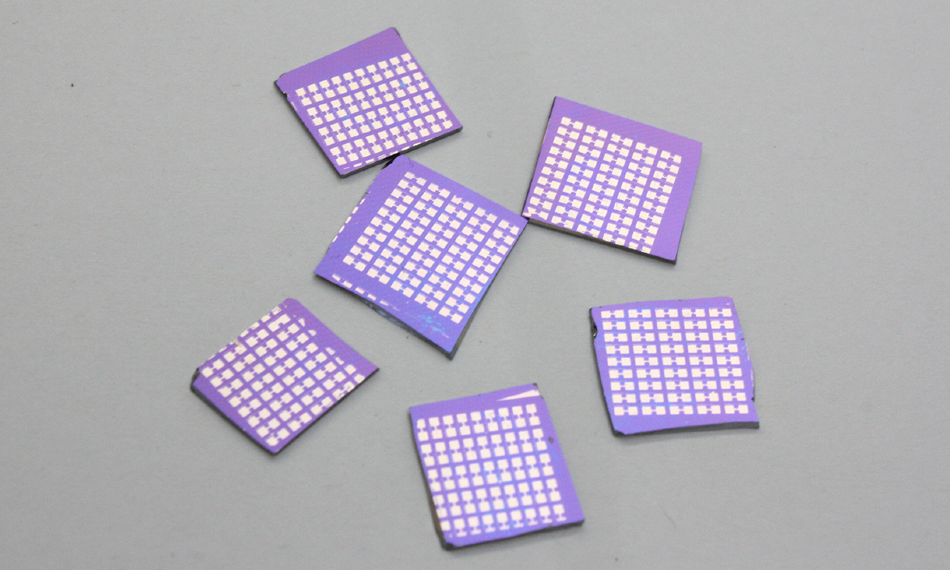Sep 23 2020
Scientists have created the world’s first photodetector that can visualize all shades of light, in a prototype device that profoundly shrinks one of the most underlying elements of contemporary technology.
 The new hyper-efficient broadband photodetector developed by researchers at RMIT University is at least 1,000 times thinner than the smallest commercially available photodetector device. Image Credit: RMIT University.
The new hyper-efficient broadband photodetector developed by researchers at RMIT University is at least 1,000 times thinner than the smallest commercially available photodetector device. Image Credit: RMIT University.
The function of photodetectors is to convert data carried by light into an electrical signal. They are used in a broad range of technologies, right from medical imaging to gaming consoles, fiber optic communication, and motion detectors.
At present, photodetectors are incapable of sensing more than one color in a single device. This means they have continued to remain slower and bigger than other technologies, similar to the silicon chip, that they combine with.
The new highly-efficient broadband photodetector built by RMIT University scientists is at least 1,000 times thinner than the smallest photodetector device available in the market.
In a major leap for the technology, the prototype device is also capable of seeing all shades of light between near-infrared and ultraviolet, paving the way for new opportunities to incorporate optical and electrical components on the same chip.
New Possibilities
The innovative technology also paves the way for better biomedical imaging, improving early detection of health problems like cancer.
According to Vaishnavi Krishnamurthi, the study’s lead author and Ph.D. researcher, in photodetection technologies, creating a thinner material would mean compromising on performance.
But we managed to engineer a device that packs a powerful punch, despite being thinner than a nanometre, which is roughly a million times smaller than the width of a pinhead.
Vaishnavi Krishnamurthi, Study Lead Author and PhD Researcher, RMIT University
In addition to reducing the size of medical imaging equipment, the ultra-thin prototype opens the door for low-light imaging, more effective motion detectors, and possibly faster fiber optical communication.
Smaller photodetectors in biomedical imaging equipment could lead to more accurate targeting of cancer cells during radiation therapy. Shrinking the technology could also help deliver smaller, portable medical imaging systems that could be brought into remote areas with ease, compared to the bulky equipment we have today.
Vaishnavi Krishnamurthi, Study Lead Author and PhD Researcher, RMIT University
Lighting up the Spectrum
The level of usefulness and versatility of photodetectors are largely dependent on three factors: their sensitivity to lower levels of light, their running speed, and the amount of the spectrum that can be detected by them.
Normally, when engineers have attempted to enhance the capabilities of a photodetector in one of those areas, at least one of the other features has been reduced. Existing photodetector technology depends on a stacked structure of three to four layers.
Individuals can visualize a sandwich made with bread, cheese, butter, and another layer of bread—and irrespective of how good they are at squashing it, the sandwich will invariably have the same thickness of four layers, and if a layer is removed, the quality would be compromised.
The team from RMIT University’s School of Engineering rejected the stacked model and explored how to use a nano thin layer (only a single atom thick) on a chip.
Most significantly, they did this without reducing the photodetector’s speed, visibility, or low-light sensitivity of the spectrum.
The prototype device can deduce light ranging from deep ultraviolet to near-infrared wavelengths, rendering it sensitive to a wider spectrum than a human eye.
And it does this more than 10,000 times faster than the blink of an eye.
Nano-Thin Technology
A huge challenge for the researchers was to make sure that optical and electronic properties did not decline when the size of the photodetector was reduced—a technological bottleneck that had formerly inhibited the miniaturization of light detection technologies.
Professor Sumeet Walia, chief investigator and Associate¸ explained that the material used—tin monosulfide—is economical and naturally abundant, making it advantageous for optoelectronics and electronics.
The material allows the device to be extremely sensitive in low-lighting conditions, making it suitable for low-light photography across a wide light spectrum.
Sumeet Walia, Chief Investigator and Associate Professor, RMIT University
Walia added that his team is currently exploring industry applications for their photodetector, which can be combined with present-day technologies, like CMOS chips.
“With further development, we could be looking at applications including more effective motion detection in security cameras at night and faster, more efficient data storage,” Walia concluded.
Journal Reference:
Krishnamurthi, V., et al. (2020) Liquid-metal synthesized ultra-thin SnS layers for high-performance broadband photodetectors. Advanced Materials. doi.org/10.1002/adma.202004247.